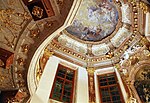Museum of Military History, Vienna
1856 establishments in the Austrian Empire19th-century architecture in AustriaBuildings and structures in LandstraßeGovernment buildings completed in 1856Infrastructure completed in 1856 ... and 6 more
Military and war museums in AustriaMuseums in ViennaTheophil Hansen buildingsUse British English from January 2015World War II museumsWorld War I museums

The Museum of Military History – Military History Institute (German: Heeresgeschichtliches Museum – Militärhistorisches Institut) in Vienna is the leading museum of the Austrian Armed Forces. It documents the history of Austrian military affairs through a wide range of exhibits comprising, above all, weapons, armours, tanks, aeroplanes, uniforms, flags, paintings, medals and badges of honour, photographs, battleship models, and documents. Although the museum is owned by the Federal Government, it is not affiliated to the Federal museums but is organised as a subordinate agency reporting directly to the Ministry of Defence and Sports.
Excerpt from the Wikipedia article Museum of Military History, Vienna (License: CC BY-SA 3.0, Authors, Images).Museum of Military History, Vienna
Ghegastraße, Vienna KG Landstraße (Landstraße)
Geographical coordinates (GPS) Address Nearby Places Show on map
Geographical coordinates (GPS)
| Latitude | Longitude |
|---|---|
| N 48.185277777778 ° | E 16.3875 ° |
Address
Objekt 1
Ghegastraße
1030 Vienna, KG Landstraße (Landstraße)
Austria
Open on Google Maps










